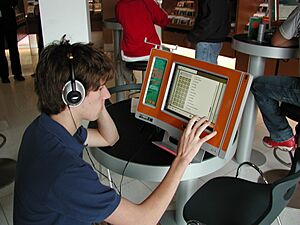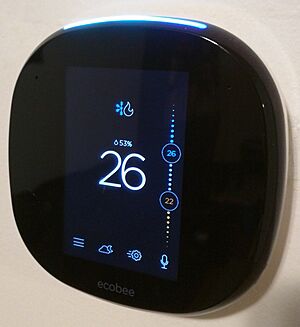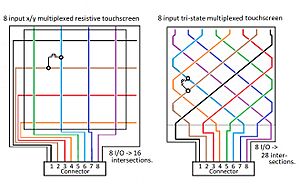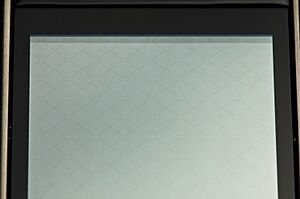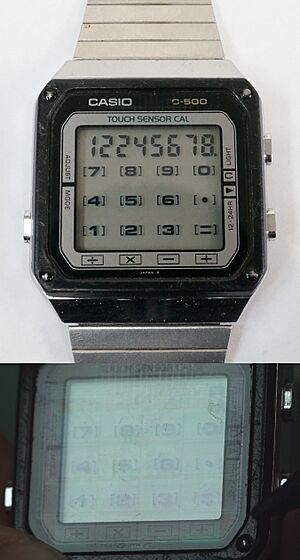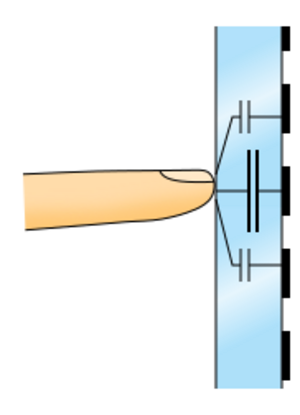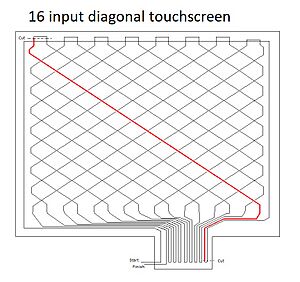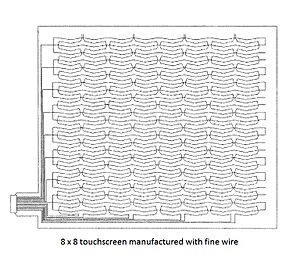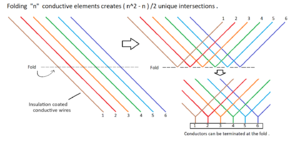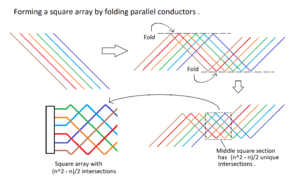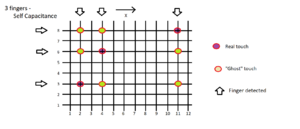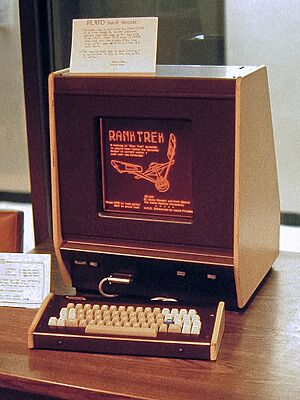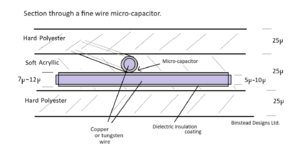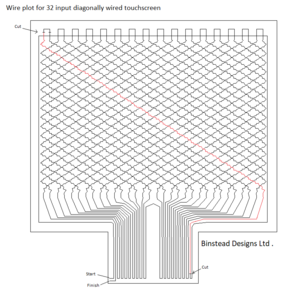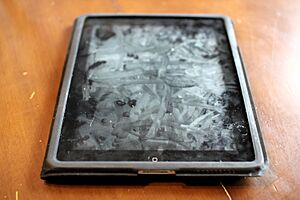Touchscreen facts for kids
A touchscreen (or touch screen) is a type of display that can detect touch input from a user. It consists of both an input device (a touch panel) and an output device (a visual display). The touch panel is typically layered on the top of the electronic visual display of a device. Touchscreens are commonly found in smartphones, tablets, laptops, and other electronic devices.
The display is often an LCD, AMOLED or OLED display.
A user can give input or control the information processing system through simple or multi-touch gestures by touching the screen with a special stylus or one or more fingers. Some touchscreens use ordinary or specially coated gloves to work, while others may only work using a special stylus or pen. The user can use the touchscreen to react to what is displayed and, if the software allows, to control how it is displayed; for example, zooming to increase the text size.
A touchscreen enables the user to interact directly with what is displayed, instead of using a mouse, touchpad, or other such devices (other than a stylus, which is optional for most modern touchscreens).
Touchscreens are common in devices such as smartphones, handheld game consoles, and personal computers. They are common in point-of-sale (POS) systems, automated teller machines (ATMs), and electronic voting machines. They can also be attached to computers or, as terminals, to networks. They play a prominent role in the design of digital appliances such as personal digital assistants (PDAs) and some e-readers. Touchscreens are important in educational settings such as classrooms or on college campuses.
The popularity of smartphones, tablets, and many types of information appliances has driven the demand and acceptance of common touchscreens for portable and functional electronics. Touchscreens are found in the medical field, heavy industry, automated teller machines (ATMs), and kiosks such as museum displays or room automation, where keyboard and mouse systems do not allow a suitably intuitive, rapid, or accurate interaction by the user with the display's content.
Historically, the touchscreen sensor and its accompanying controller-based firmware have been made available by a wide array of after-market system integrators, and not by display, chip, or motherboard manufacturers. Display manufacturers and chip manufacturers have acknowledged the trend toward acceptance of touchscreens as a user interface component and have begun to integrate touchscreens into the fundamental design of their products.
Contents
Technologies
There are a number of touchscreen technologies, with different methods of sensing touch.
Resistive
A resistive touchscreen panel comprises several thin layers, the most important of which are two transparent electrically resistive layers facing each other with a thin gap between. The top layer (that which is touched) has a coating on the underside surface; just beneath it is a similar resistive layer on top of its substrate. One layer has conductive connections along its sides, the other along top and bottom. A voltage is applied to one layer and sensed by the other. When an object, such as a fingertip or stylus tip, presses down onto the outer surface, the two layers touch to become connected at that point. The panel then behaves as a pair of voltage dividers, one axis at a time. By rapidly switching between each layer, the position of pressure on the screen can be detected.
Resistive touch is used in restaurants, factories and hospitals due to its high tolerance for liquids and contaminants. A major benefit of resistive-touch technology is its low cost. Additionally, as only sufficient pressure is necessary for the touch to be sensed, they may be used with gloves on, or by using anything rigid as a finger substitute. Disadvantages include the need to press down, and a risk of damage by sharp objects. Resistive touchscreens also suffer from poorer contrast, due to having additional reflections (i.e. glare) from the layers of material placed over the screen. This type of touchscreen has been used by Nintendo in the DS family, the 3DS family, and the Wii U GamePad.
Due to their simple structure, with very few inputs, resistive touchscreens are mainly used for single touch operation, although some two touch versions (often described as multi-touch) are available. There are, however, some true multi-touch resistive touchscreens available. These need many more inputs, and rely on x/y multiplexing to keep the I/O count down.
One example of a true multi-touch resistive touchscreen, can detect 10 fingers at the same time. This has 80 I/O connections. These are possibly split 34 x inputs / 46 y outputs, forming a standard 3:4 aspect ratio touchscreen with 1564 x/y intersecting touch sensing nodes.
Tri-state multiplexing could have been used instead of x/y multiplexing. This would have reduced the I/O count from 80 to 60 while creating 1770 unique touch sensing nodes, with no need for a bezel, and with all inputs coming from just one edge.
Surface acoustic wave
Surface acoustic wave (SAW) technology uses ultrasonic waves that pass over the touchscreen panel. When the panel is touched, a portion of the wave is absorbed. The change in ultrasonic waves is processed by the controller to determine the position of the touch event. Surface acoustic wave touchscreen panels can be damaged by outside elements. Contaminants on the surface can also interfere with the functionality of the touchscreen.
SAW devices have a wide range of applications, including delay lines, filters, correlators and DC to DC converters.
Capacitive touchscreen
A capacitive touchscreen panel consists of an insulator, such as glass, coated with a transparent conductor, such as indium tin oxide (ITO). As the human body is also an electrical conductor, touching the surface of the screen results in a distortion of the screen's electrostatic field, measurable as a change in capacitance. Different technologies may be used to determine the location of the touch. The location is then sent to the controller for processing. Some touchscreens use silver instead of ITO, as ITO causes several environmental problems due to the use of indium. The controller is typically a complementary metal–oxide–semiconductor (CMOS) application-specific integrated circuit (ASIC) chip, which in turn usually sends the signals to a CMOS digital signal processor (DSP) for processing.
Unlike a resistive touchscreen, some capacitive touchscreens cannot be used to detect a finger through electrically insulating material, such as gloves. This disadvantage especially affects usability in consumer electronics, such as touch tablet PCs and capacitive smartphones in cold weather when people may be wearing gloves. It can be overcome with a special capacitive stylus, or a special-application glove with an embroidered patch of conductive thread allowing electrical contact with the user's fingertip.
A low-quality switching-mode power supply unit with an accordingly unstable, noisy voltage may temporarily interfere with the precision, accuracy and sensitivity of capacitive touch screens.
Some capacitive display manufacturers continue to develop thinner and more accurate touchscreens. Those for mobile devices are now being produced with 'in-cell' technology, such as in Samsung's Super AMOLED screens, that eliminates a layer by building the capacitors inside the display itself. This type of touchscreen reduces the visible distance between the user's finger and what the user is touching on the screen, reducing the thickness and weight of the display, which is desirable in smartphones.
A simple parallel-plate capacitor has two conductors separated by a dielectric layer. Most of the energy in this system is concentrated directly between the plates. Some of the energy spills over into the area outside the plates, and the electric field lines associated with this effect are called fringing fields. Part of the challenge of making a practical capacitive sensor is to design a set of printed circuit traces which direct fringing fields into an active sensing area accessible to a user. A parallel-plate capacitor is not a good choice for such a sensor pattern. Placing a finger near fringing electric fields adds conductive surface area to the capacitive system. The additional charge storage capacity added by the finger is known as finger capacitance, or CF. The capacitance of the sensor without a finger present is known as parasitic capacitance, or CP.
Surface capacitance
In this basic technology, only one side of the insulator is coated with a conductive layer. A small voltage is applied to the layer, resulting in a uniform electrostatic field. When a conductor, such as a human finger, touches the uncoated surface, a capacitor is dynamically formed. The sensor's controller can determine the location of the touch indirectly from the change in the capacitance as measured from the four corners of the panel. As it has no moving parts, it is moderately durable but has limited resolution, is prone to false signals from parasitic capacitive coupling, and needs calibration during manufacture. It is therefore most often used in simple applications such as industrial controls and kiosks.
Although some standard capacitance detection methods are projective, in the sense that they can be used to detect a finger through a non-conductive surface, they are very sensitive to fluctuations in temperature, which expand or contract the sensing plates, causing fluctuations in the capacitance of these plates. These fluctuations result in a lot of background noise, so a strong finger signal is required for accurate detection. This limits applications to those where the finger directly touches the sensing element or is sensed through a relatively thin non-conductive surface.
Projected capacitance
Projected capacitive touch (PCT; also PCAP) technology is a variant of capacitive touch technology but where sensitivity to touch, accuracy, resolution and speed of touch have been greatly improved by the use of a simple form of artificial intelligence. This intelligent processing enables finger sensing to be projected, accurately and reliably, through very thick glass and even double glazing.
Projected capacitance is a method for accurately detecting and tracking a particular variable, or group of variables (such as finger(s)), by: a) using a simple form of artificial intelligence to develop a profile of the capacitance changing effects expected for that variable, b) specifically looking for such changes, and c) eliminating measured capacitance changes that do not match this profile, attributable to global variables (such as temperature/humidity, dirt build-up, electrical noise), and local variables (such as rain drops, partial shade and hands/elbows). Capacitance sensors may be discrete - possibly (but not necessarily) in a regular array, or they may be multiplexed.
Assumptions.
In practice, various assumptions are made, such as: - a) fingers will not be touching the screen at "power-up", b) a finger will not be on the same spot for more than a fixed period of time, and c) fingers will not be touching everywhere at the same time.
a) If a finger IS touching the screen at "power-up", then, as soon as it is removed a large "anti-touch" capacitance change will be detected. This signals to the processor to reset the touch thresholds and store new "no touch" values for each input.
b) Long-term drift compensation is used to gradually raise or lower these thresholds (trending eventually to "no-touch"). This compensates for global changes in temperature and humidity. It also eliminates the possibility of any position appearing to be touched for too long, due to some "non-finger" event. This might be caused, for example, by a wet leaf landing on, and sticking to the screen.
c) When a decision is to be made about the validity of one or more touches, then, assumption c) means that the average value, of changes measured for some of the inputs with the smallest change, can be used to "offset" the touch thresholds of the inputs in contention. This minimizes the influence of hands and arms.
By these and other means, the processor is constantly fine tuning the touch thresholds, and tweaking the touch sensitivity of each input. This enables very small changes, caused only by fingers, to be accurately detected through thick overlays, or several centimeters of air.
When a conductive object, such as a finger, comes into contact with a PCT panel, it distorts the local electrostatic field at that point. This is measurable as a change in capacitance. If a finger bridges the gap between two of the "tracks", the charge field is further interrupted and detected by the controller. The capacitance can be changed and measured at every individual point on the grid. This system is able to accurately track touches.
Due to the top layer of a PCT being glass, it is sturdier than less-expensive resistive touch technology. Unlike traditional capacitive touch technology, it is possible for a PCT system to sense a passive stylus or gloved fingers.
Moisture on the surface of the panel, high humidity, or collected dust are not a problem, especially with 'fine wire' based touchscreens due to the fact that wire based touchscreens have a very low 'parasitic' capacitance, and there is a greater distance between neighboring conductors. Projected capacitance has "long term drift compensation" built in. This minimizes the effects of slowly changing environmental factors, such as the build-up of dirt and effects caused by changes in the weather. Drops of rain have little effect, but flowing water, and especially flowing sea water (due to its electrical conductivity), can cause short term issues.
A high frequency (RF) signal, possibly from 100 kHz to 1 MHz, is imposed on one track at a time, and appropriate capacitance measurements are taken ( as described later in this article). This process is repeated until all the tracks have been sampled.
Conductive tracks are often transparent, one example being Indium tin oxide (ITO), a transparent electrical conductor, but these conductive tracks can be made of very fine, non-transparent metal mesh or individual fine wires.
Projected capacitance touchscreen layout.
Layout can vary depending on whether a single finger is to be detected or multiple fingers.
In order to detect many fingers at the same time, some modern PCT touch screens are composed of thousands of discrete keys, each key being linked individually to the edge of the touch screen. This is enabled by etching an electrode grid pattern in a transparent conductive coating on one side of a sheet of glass or plastic.
To reduce the number of input tracks, most PCT touch screens use multiplexing. This enables, for example, 100 (n) discrete key inputs to be reduced to 20  when using x/y multiplexing, or 15
when using x/y multiplexing, or 15  if using bistate multiplexing or tri-state multiplexing.
if using bistate multiplexing or tri-state multiplexing.
Capacitance multiplexing requires a grid of intersecting, but electrically isolated conductive tracks. This can be achieved in many different ways. One way is by creating parallel conductive tracks on one side of a plastic film, and similar parallel tracks on the other side, orientated at 90 degrees to the first side.
Another way is to etch tracks on separate sheets of glass, and join these sheets, with tracks at right angles to each other, face to face using a thin non-conductive, adhesive interlayer.
A simple alternative is to embed an x/y or diagonal grid of very fine, insulation coated conductive wires in a thin polyester film. This film can then be attached to one side of a sheet of glass, for operation through the glass.
Touch resolution and the number of fingers that can be detected simultaneously is determined by the number of cross-over points (x * y). If x + y = n, then the maximum possible number of cross-overs is (n/2)2. However, the number of cross-over points can be almost doubled by using a diagonal lattice layout ( see Lattice/diagonal touchscreen diagrams ) where, instead of x elements only ever crossing y elements, each conductive element crosses every other element. Under these circumstances the maximum number of cross-overs is (n2-n)/2. All the connector inputs come from just one edge.
See video (above) of raw data from 32 input diagonally wired touchscreen.
Diagonal touchscreen arrays
In 2015, a new diagonal array, suited to a range of touchscreen and keypad technologies, was invented and patented by Ron Binstead of Binstead Designs Ltd.
The diagram (left) shows how a group of 6 parallel conductive elements, folded back on themselves (at right angles), can create a triangular array of 15 unique intersections. An x/y array, with 6 conductive elements, would only have created a maximum of 9 unique intersections.
Although conductive elements are normally connected to a terminal at one end of the conductor, the left diagram shows that these folded elements can be terminated at the fold, thereby forming split (or bifurcated) elements.
A square/rectangular diagonal array can be formed by double folding the parallel conductors - see diagram on the right. Two connectors could be fitted at the folds, on opposite sides of the array. Alternatively, a single connector can be fitted at one end of the array - as shown in the diagram.
Cylindrical touchscreens.
Diagonal sensing elements can also be formed into a seamless cylindrical array. The diagram on the right shows a split, 9 I/O, bi-state cylindrical layout, with 36 unique intersections - all the I/O lines connected to one end of the cylinder (a standard x/y array would require horizontal I/O lines entering the side of the cylinder). Unsplit diagonal sensing elements can also be formed into cylinders, but 9 I/Os would only create 20 (5x4) unique intersections. These cylinders can be physically transformed into complex 3 dimensional shapes, by a range of different methods, such as blow molding, vacuum forming, etc..
A similar layout is possible for a complementary cylindrical LED display - see Charlieplexing#Diagonal arrays.
Infinitely wide touchscreens.
Touchscreen width is normally restricted by the resistance of the conductive material used. As the width of an x/y touchscreen is increased, eventually the resistance of the horizontal conductors becomes too great for the touchscreen to work properly. "Infinitely" wide touchscreens are possible, however, when using diagonal wiring, because track lengths are always 1.414 x the height of the touchscreen  , and are independent of touchscreen width (see diagram on right).
, and are independent of touchscreen width (see diagram on right).
There are two types of PCT: mutual capacitance and self-capacitance
Mutual capacitance
An electrical signal, imposed on one electrical conductor, can be capacitively "sensed" by another electrical conductor that is in very close proximity, but electrically isolated—a feature that is exploited in mutual capacitance touchscreens. In a mutual capacitive sensor array, the "mutual" crossing of one electrical conductor with another electrical conductor, but with no direct electrical contact, forms a capacitor (see touchscreen#Construction).
High frequency voltage pulses are applied to these conductors, one at a time. These pulses capacitively couple to every conductor that intersects it.
Bringing a finger or conductive stylus close to the surface of the sensor changes the local electrostatic field, which in turn reduces the capacitance between these intersecting conductors. Any significant change in the strength of the signal sensed is used to determine if a finger is present or not at an intersection.
The capacitance change at every intersection on the grid can be measured to accurately determine one or more touch locations.
Mutual capacitance allows multi-touch operation where multiple fingers, palms or styli can be accurately tracked at the same time.The greater the number of intersections, the better the touch resolution and the more independent fingers that can be detected. This indicates a distinct advantage of diagonal wiring over standard x/y wiring, since diagonal wiring creates nearly twice the number of intersections.
A 30 i/o, 16×14 x/y array, for example, would have 224 of these intersections / capacitors, and a 30 i/o diagonal lattice array could have 435 intersections.
Each trace of an x/y mutual capacitance array only has one function, it is either an input or an output. The horizontal traces may be transmitters while the vertical traces are sensors, or vice versa.
The traces in a diagonal mutual capacitance array, however, have to continuously change their functionality, "on the fly", by a process called bi-state multiplexing or Tri-state multiplexing. Some of the time a trace will be an output, at another time it will be an input or "grounded". A "look-up" table can be used to simplify this process. By slightly distorting the conductors in a "n" I/O diagonal matrix, the equivalent of a (n-1) by (n/2) array is formed. After address decoding, this can then be processed as a standard x/y array.
Self-capacitance
Self-capacitance sensors can have the same X/Y or diagonal grid layout as mutual capacitance sensors, but, with self-capacitance all the traces usually operate independently, with no interaction between different traces. Along with several other methods, the extra capacitive load of a finger on a trace electrode may be measured by a current meter, or by the change in frequency of an RC oscillator.
Traces are sensed, one after the other until all the traces have been sensed. A finger may be detected anywhere along the whole length of a trace (even "off-screen"), but there is no indication where the finger is along that trace. If, however, a finger is also detected along another intersecting trace, then it is assumed that the finger position is at the intersection of the two traces. This allows for the speedy and accurate detection of a single finger.
There is, however, ambiguity if more than one finger is to be detected. Two fingers may have four possible detection positions, only two of which are true, the other two being "ghosts." However, by selectively de-sensitizing any touch-points in contention, conflicting results are easily resolved. This enables self-capacitance to be used for two touch operation.
Although mutual capacitance is simpler for multi-touch, multi-touch can be achieved using self-capacitance.
If the trace being sensed is intersected by another trace that has a "desensitizing" signal on it, then that intersection is insensitive to touch. By imposing such a "desensitizing" signal on all the intersecting traces, except one, along the trace being sensed, then just a short length of that trace will be sensitive to touch. By selecting a sequence of these sensing sections along the trace, it is possible to determine the accurate position of multiple fingers along the one trace. This process can then be repeated for all the other traces until the whole screen has been scanned.
Self-capacitive touch screen layers are used on mobile phones such as the Sony Xperia Sola, the Samsung Galaxy S4, Galaxy Note 3, Galaxy S5, and Galaxy Alpha.
Self-capacitance is far more sensitive than mutual capacitance and is mainly used for single touch, simple gesturing and proximity sensing where the finger does not even have to touch the glass surface. Mutual capacitance is mainly used for multitouch applications. Many touchscreen manufacturers use both self and mutual capacitance technologies in the same product, thereby combining their individual benefits.
Self-capacitance vs. mutual capacitance
When using a 16 x 14 X/Y array to determine the position of a single finger by self-capacitance, 30 (i.e. 16 + 14) capacitance measurements are required. The finger being determined to be at the intersection of the strongest of the 16 x measurements and the strongest of the 14 y measurements. However, when using mutual capacitance, every intersection may have to be measured, making a total of 224 (i.e. 16 x 14) capacitance measurements. In this example, therefore, mutual capacitance requires nearly 7 times as many measurements as self-capacitance to detect the position of a finger.
Many applications, such as selecting items from a list or menu, require just one finger, and self-capacitance is eminently suitable for such applications, due to the relatively low processing load, simpler processing method, the ability to sense through thick dielectric materials or air, and the possibility of reducing the number of inputs required, through repeat track layouts.
For many other applications, however, such as for expanding / contracting items on the screen and for other gestures, two or more fingers need to be tracked.
Two fingers can be detected and tracked accurately using self-capacitance, but this does involve a few extra calculations, and 4 extra capacitance measurements to eliminate the 2 "ghost" positions. One method is to undertake a full self-capacitance scan, to detect the 4 ambiguous finger positions, then use just 4 targeted mutual capacitance measurements to discover which two of the 4 positions are valid and which 2 are not. This gives a total of 34 measurements—still far less than the 224 required when using mutual capacitance alone.
With 3 fingers, 9 disambiguations are required; with 4 fingers, 16 disambiguations etc.
With more fingers, it may be decided that the process of disambiguation is too unwieldy. If sufficient processing power is available, the switch can then be made to full mutual capacitance scanning.
Use of stylus on capacitive screens
Capacitive touchscreens do not necessarily need to be operated by a finger, but until recently the special styli required could be quite expensive to purchase. The cost of this technology has fallen greatly in recent years and capacitive styli are now widely available for a nominal charge, and often given away free with mobile accessories. These consist of an electrically conductive shaft with a soft conductive rubber tip, thereby resistively connecting the fingers to the tip of the stylus.
Infrared grid
An infrared touchscreen uses an array of X-Y infrared LED and photodetector pairs around the edges of the screen to detect a disruption in the pattern of LED beams. These LED beams cross each other in vertical and horizontal patterns. This helps the sensors pick up the exact location of the touch. A major benefit of such a system is that it can detect essentially any opaque object including a finger, gloved finger, stylus or pen. It is generally used in outdoor applications and POS systems that cannot rely on a conductor (such as a bare finger) to activate the touchscreen. Unlike capacitive touchscreens, infrared touchscreens do not require any patterning on the glass which increases durability and optical clarity of the overall system. Infrared touchscreens are sensitive to dirt and dust that can interfere with the infrared beams, and suffer from parallax in curved surfaces and accidental press when the user hovers a finger over the screen while searching for the item to be selected.
Infrared acrylic projection
A translucent acrylic sheet is used as a rear-projection screen to display information. The edges of the acrylic sheet are illuminated by infrared LEDs, and infrared cameras are focused on the back of the sheet. Objects placed on the sheet are detectable by the cameras. When the sheet is touched by the user, frustrated total internal reflection results in leakage of infrared light which peaks at the points of maximum pressure, indicating the user's touch location. Microsoft's PixelSense tablets use this technology.
Optical imaging
Optical touchscreens are a relatively modern development in touchscreen technology, in which two or more image sensors (such as CMOS sensors) are placed around the edges (mostly the corners) of the screen. Infrared backlights are placed in the sensor's field of view on the opposite side of the screen. A touch blocks some lights from the sensors, and the location and size of the touching object can be calculated (see visual hull). This technology is growing in popularity due to its scalability, versatility, and affordability for larger touchscreens.
Dispersive signal technology
Introduced in 2002 by 3M, this system detects a touch by using sensors to measure the piezoelectricity in the glass. Complex algorithms interpret this information and provide the actual location of the touch. The technology is unaffected by dust and other outside elements, including scratches. Since there is no need for additional elements on screen, it also claims to provide excellent optical clarity. Any object can be used to generate touch events, including gloved fingers. A downside is that after the initial touch, the system cannot detect a motionless finger. However, for the same reason, resting objects do not disrupt touch recognition.
Acoustic pulse recognition
The key to this technology is that a touch at any one position on the surface generates a sound wave in the substrate which then produces a unique combined signal as measured by three or more tiny transducers attached to the edges of the touchscreen. The digitized signal is compared to a list corresponding to every position on the surface, determining the touch location. A moving touch is tracked by rapid repetition of this process. Extraneous and ambient sounds are ignored since they do not match any stored sound profile. The technology differs from other sound-based technologies by using a simple look-up method rather than expensive signal-processing hardware. As with the dispersive signal technology system, a motionless finger cannot be detected after the initial touch. However, for the same reason, the touch recognition is not disrupted by any resting objects. The technology was created by SoundTouch Ltd in the early 2000s, as described by the patent family EP1852772, and introduced to the market by Tyco International's Elo division in 2006 as Acoustic Pulse Recognition. The touchscreen used by Elo is made of ordinary glass, giving good durability and optical clarity. The technology usually retains accuracy with scratches and dust on the screen. The technology is also well suited to displays that are physically larger.
Construction
There are several principal ways to build a touchscreen. The key goals are to recognize one or more fingers touching a display, to interpret the command that this represents, and to communicate the command to the appropriate application.
Multi-touch projected capacitance screens
A very simple, low cost way to make a multi-touch projected capacitance touchscreen, is to sandwich an x/y or diagonal matrix of fine, insulation coated copper or tungsten wires between two layers of clear polyester film. This creates an array of proximity sensing micro-capacitors. One of these micro-capacitors every 10 to 15 mm is probably sufficient spacing if fingers are relatively widely spaced apart, but very high discrimination multi-touch may need a micro-capacitor every 5 or 6 mm. A similar system can be used for ultra-high resolution sensing, such as fingerprint sensing. Fingerprint sensors require a micro-capacitor spacing of about 44 to 50 microns.
The touchscreens can be manufactured at home, using readily available tools and materials, or it can be done industrially.
First, a "continuous-trace" wiring pattern is generated using a simple CAD system.
The wire is threaded through a plotter pen and plotted directly, as one continuous wire, onto a thin sheet of adhesive coated, clear polyester film (such as "window film"), using a standard, low cost x/y pen plotter. After plotting, the single wire is gently cut into individual sections with a sharp scalpel, taking care not to damage the film.
A second identical polyester film is laminated over the first film. The resulting touchscreen film is then trimmed to shape, and a connector is retro-fitted.
The end product is extremely flexible, being about 75 microns thick (about the thickness of a human hair). It can even be creased without loss of functionality.
The film can be mounted on, or behind non-conducting (or slightly conducting) surfaces. Usually, it is mounted behind a sheet of glass up to 12 mm thick (or more), for sensing through the glass.
This method is suitable for a wide range of touchscreen sizes from very small to several meters wide - or even wider, if using a diagonally wired matrix.
The end product is environmentally friendly as it uses recyclable polyester, and minute quantities of copper wire. The film could even have a second life as another product, such as drawing film, or wrapping film. Unlike some other touchscreen technologies, no complex processes or rare materials are used.
For non-touchscreen applications, other plastics (e.g. vinyl or ABS) may be used. The film can be blow molded or heat formed into complex three dimensional shapes, such as bottles, globes or car dashboards. Alternatively, the wires can be embedded in thick plastic such as fiber glass or carbon fiber body panels.
Single touch resistive touchscreens
In the resistive approach, which used to be the most popular technique, there are typically four layers:
- Top polyester-coated layer with a transparent metallic-conductive coating on the bottom.
- Adhesive spacer
- Glass layer coated with a transparent metallic-conductive coating on the top
- Adhesive layer on the backside of the glass for mounting.
When a user touches the surface, the system records the change in the electric current that flows through the display.
Dispersive signal
Dispersive signal technology measures the piezoelectric effect—the voltage generated when mechanical force is applied to a material that occurs chemically when a strengthened glass substrate is touched.
Infrared
There are two infrared-based approaches. In one, an array of sensors detects a finger touching or almost touching the display, thereby interrupting infrared light beams projected over the screen. In the other, bottom-mounted infrared cameras record heat from screen touches.
In each case, the system determines the intended command based on the controls showing on the screen at the time and the location of the touch.
Development
The development of multi-touch screens facilitated the tracking of more than one finger on the screen; thus, operations that require more than one finger are possible. These devices also allow multiple users to interact with the touchscreen simultaneously.
With the growing use of touchscreens, the cost of touchscreen technology is routinely absorbed into the products that incorporate it and is nearly eliminated. Touchscreen technology has demonstrated reliability and is found in airplanes, automobiles, gaming consoles, machine control systems, appliances, and handheld display devices including cellphones; the touchscreen market for mobile devices was projected to produce US$5 billion by 2009.
The ability to accurately point on the screen itself is also advancing with the emerging graphics tablet-screen hybrids. Polyvinylidene fluoride (PVDF) plays a major role in this innovation due its high piezoelectric properties, which allow the tablet to sense pressure, making such things as digital painting behave more like paper and pencil.
TapSense, announced in October 2011, allows touchscreens to distinguish what part of the hand was used for input, such as the fingertip, knuckle and fingernail. This could be used in a variety of ways, for example, to copy and paste, to capitalize letters, to activate different drawing modes, etc.
Ergonomics and usage
Touchscreen enable
For touchscreens to be effective input devices, users must be able to accurately select targets and avoid accidental selection of adjacent targets. The design of touchscreen interfaces should reflect technical capabilities of the system, ergonomics, cognitive psychology and human physiology.
Guidelines for touchscreen designs were first developed in the 2000s, based on early research and actual use of older systems, typically using infrared grids—which were highly dependent on the size of the user's fingers. These guidelines are less relevant for the bulk of modern touch devices which use capacitive or resistive touch technology.
From the mid-2000s, makers of operating systems for smartphones have promulgated standards, but these vary between manufacturers, and allow for significant variation in size based on technology changes, so are unsuitable from a human factors perspective.
Much more important is the accuracy humans have in selecting targets with their finger or a pen stylus. The accuracy of user selection varies by position on the screen: users are most accurate at the center, less so at the left and right edges, and least accurate at the top edge and especially the bottom edge. The R95 accuracy (required radius for 95% target accuracy) varies from 7 mm (0.28 in) in the center to 12 mm (0.47 in) in the lower corners. Users are subconsciously aware of this, and take more time to select targets which are smaller or at the edges or corners of the touchscreen.
This user inaccuracy is a result of parallax, visual acuity and the speed of the feedback loop between the eyes and fingers. The precision of the human finger alone is much, much higher than this, so when assistive technologies are provided—such as on-screen magnifiers—users can move their finger (once in contact with the screen) with precision as small as 0.1 mm (0.004 in).
Hand position, digit used and switching
Users of handheld and portable touchscreen devices hold them in a variety of ways, and routinely change their method of holding and selection to suit the position and type of input. There are four basic types of handheld interaction:
- Holding at least in part with both hands, tapping with a single thumb
- Holding with two hands and tapping with both thumbs
- Holding with one hand, tapping with the finger (or rarely, thumb) of another hand
- Holding the device in one hand, and tapping with the thumb from that same hand
Use rates vary widely. While two-thumb tapping is encountered rarely (1–3%) for many general interactions, it is used for 41% of typing interaction.
In addition, devices are often placed on surfaces (desks or tables) and tablets especially are used in stands. The user may point, select or gesture in these cases with their finger or thumb, and vary use of these methods.
Combined with haptics
Touchscreens are often used with haptic response systems. A common example of this technology is the vibratory feedback provided when a button on the touchscreen is tapped. Haptics are used to improve the user's experience with touchscreens by providing simulated tactile feedback, and can be designed to react immediately, partly countering on-screen response latency. Research from the University of Glasgow (Brewster, Chohan, and Brown, 2007; and more recently Hogan) demonstrates that touchscreen users reduce input errors (by 20%), increase input speed (by 20%), and lower their cognitive load (by 40%) when touchscreens are combined with haptics or tactile feedback. On top of this, a study conducted in 2013 by Boston College explored the effects that touchscreens haptic stimulation had on triggering psychological ownership of a product. Their research concluded that a touchscreens ability to incorporate high amounts of haptic involvement resulted in customers feeling more endowment to the products they were designing or buying. The study also reported that consumers using a touchscreen were willing to accept a higher price point for the items they were purchasing.
Customer service
Touchscreen technology has become integrated into many aspects of customer service industry in the 21st century. The restaurant industry is a good example of touchscreen implementation into this domain. Chain restaurants such as Taco Bell, Panera Bread, and McDonald's offer touchscreens as an option when customers are ordering items off the menu. While the addition of touchscreens is a development for this industry, customers may choose to bypass the touchscreen and order from a traditional cashier. To take this a step further, a restaurant in Bangalore has attempted to completely automate the ordering process. Customers sit down to a table embedded with touchscreens and order off an extensive menu. Once the order is placed it is sent electronically to the kitchen. These types of touchscreens fit under the Point of Sale (POS) systems mentioned in the lead section.
"Gorilla arm"
Extended use of gestural interfaces without the ability of the user to rest their arm is referred to as "gorilla arm". It can result in fatigue, and even repetitive stress injury when routinely used in a work setting. Certain early pen-based interfaces required the operator to work in this position for much of the workday. Allowing the user to rest their hand or arm on the input device or a frame around it is a solution for this in many contexts. This phenomenon is often cited as an example of movements to be minimized by proper ergonomic design.
Unsupported touchscreens are still fairly common in applications such as ATMs and data kiosks, but are not an issue as the typical user only engages for brief and widely spaced periods.
Fingerprints
Touchscreens can suffer from the problem of fingerprints on the display. This can be mitigated by the use of materials with optical coatings designed to reduce the visible effects of fingerprint oils. Most modern smartphones have oleophobic coatings, which lessen the amount of oil residue. Another option is to install a matte-finish anti-glare screen protector, which creates a slightly roughened surface that does not easily retain smudges.
Glove touch
Capacitive touchscreens rarely work when the user wears gloves. The thickness of the glove and the material they are made of play a significant role on that and the ability of a touchscreen to pick up a touch.
Some devices have a mode which increases the sensitivity of the touchscreen. This allows the touchscreen to be used more reliably with gloves, but can also result in unreliable and phantom inputs. However, thin gloves such as medical gloves are thin enough for users to wear when using touchscreens; mostly applicable to medical technology and machines.
See also
 In Spanish: Pantalla táctil para niños
In Spanish: Pantalla táctil para niños
- Dual-touchscreen
- Pen computing
- Energy harvesting
- Flexible keyboard
- One Glass Solution
- Gestural interface
- Graphics tablet
- Light pen
- List of touch-solution manufacturers
- Lock screen
- Tablet computer
- Touch switch
- Touchscreen remote control
- Multi-touch
- Omnitouch
- Pointing device gesture
- Sensacell
- SixthSense
- Nintendo DS


